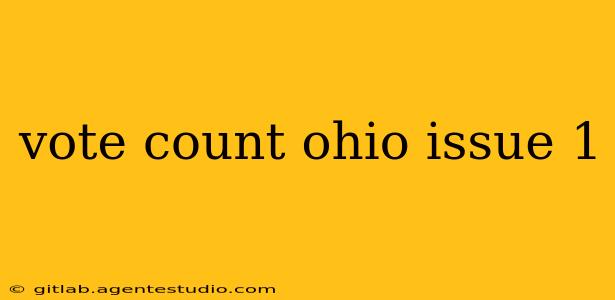The August 8th, 2023, special election in Ohio saw voters decisively reject Issue 1, a proposed constitutional amendment that would have made it harder to amend the state's constitution. This article provides a detailed breakdown of the vote count, analyzing the results and their implications for the future of Ohio politics.
Understanding Issue 1
Issue 1 aimed to raise the threshold for passing future constitutional amendments from a simple majority (50% + 1 vote) to 60%. Supporters argued this change would protect the Ohio Constitution from radical changes driven by special interests. Opponents, however, countered that it was a blatant attempt to suppress voter rights and make it more difficult to pass progressive legislation.
The Final Vote Count: A Resounding "No"
While final, certified numbers may vary slightly depending on the county, the unofficial results paint a clear picture: Issue 1 was overwhelmingly defeated. Preliminary counts showed a significant margin of "No" votes across the state. This rejection signals a strong public sentiment against raising the amendment threshold. Further analysis will dissect the vote count by county, revealing geographic patterns and potential correlations with demographic factors.
Key Factors Contributing to the "No" Vote
Several factors likely contributed to the defeat of Issue 1:
-
Voter Turnout: The unexpectedly high voter turnout for a special election played a significant role. Many voters, motivated by concerns about Issue 1's potential impact on future ballot initiatives, actively participated in the election.
-
Bipartisan Opposition: Issue 1 faced opposition from a broad spectrum of the political landscape, including prominent Republicans and Democrats. This unusual bipartisan unity likely contributed to its defeat.
-
Public Perception: Many voters perceived Issue 1 as an undemocratic attempt to restrict their ability to shape the state's future. This negative perception significantly influenced their voting decisions.
-
Effective Campaigning: Opponents of Issue 1 ran a highly effective campaign that successfully framed the issue as an attack on democracy. This messaging resonated strongly with voters.
Implications for November's Abortion Rights Amendment
The resounding defeat of Issue 1 has significant implications for the upcoming November election, where voters will decide on a proposed constitutional amendment that would protect abortion rights in Ohio. The high voter turnout and the clear rejection of Issue 1 suggest that the November election could see similar high engagement, potentially impacting the outcome of the abortion rights amendment.
Ongoing Analysis and Future Research
Further analysis of the Issue 1 vote count will provide deeper insights into the factors that influenced voting patterns. Researchers will examine data at the precinct level to identify correlations between voting preferences and demographic variables such as age, income, and political affiliation. This analysis will be crucial for understanding the broader political landscape in Ohio and predicting future election outcomes.
Conclusion
The rejection of Issue 1 represents a powerful statement from Ohio voters. It underscores the importance of preserving access to the ballot box and the public's commitment to democratic participation. The high turnout and the clear result suggest that Ohioans are actively engaged in shaping their state's future, and this engagement will undoubtedly play a significant role in upcoming elections. The comprehensive analysis of this election's results will provide valuable insights for political strategists and researchers alike.

